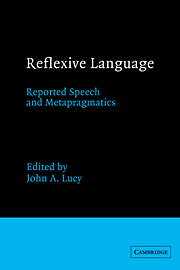Book contents
- Frontmatter
- Contents
- Acknowledgments
- General introduction
- Part I Theoretical foundations
- Part II The relation of form and function in reflexive language
- Part III Text, context, and the cultural functions of reflexive language
- Part IV Interpretation, reported speech, and metapragmatics in the Western tradition
- Introduction to Part IV
- 11 Text, transference, and indexicality
- 12 The importance of reflexive language in George H. Mead's theory of self and communication
- 13 Where epistemology, style, and grammar meet literary history: the development of represented speech and thought
- 14 Metalanguages and subjectivities
- 15 Re-creating Genesis: the metapragmatics of divine speech
- Name index
- Subject index
13 - Where epistemology, style, and grammar meet literary history: the development of represented speech and thought
from Part IV - Interpretation, reported speech, and metapragmatics in the Western tradition
Published online by Cambridge University Press: 22 January 2010
- Frontmatter
- Contents
- Acknowledgments
- General introduction
- Part I Theoretical foundations
- Part II The relation of form and function in reflexive language
- Part III Text, context, and the cultural functions of reflexive language
- Part IV Interpretation, reported speech, and metapragmatics in the Western tradition
- Introduction to Part IV
- 11 Text, transference, and indexicality
- 12 The importance of reflexive language in George H. Mead's theory of self and communication
- 13 Where epistemology, style, and grammar meet literary history: the development of represented speech and thought
- 14 Metalanguages and subjectivities
- 15 Re-creating Genesis: the metapragmatics of divine speech
- Name index
- Subject index
Summary
Poetry and eloquence are both alike the expression or utterance of feeling. But … eloquence is heard, poetry is overheard. Eloquence supposes an audience; the peculiarity of poetry appears to us to lie in the poet's utter unconsciousness of a listener.
J. S. Mill, “What is poetry?”No poem is intended for the reader, no picture for the beholder, no symphony for the listener.
Walter Benjamin, “The task of the translator”I can be using language in the strictest sense with no intention of communicating. Though my utterances have a definite meaning, their normal meaning, nevertheless my intentions with regard to an audience may shed no light on their meaning. But communication is only one function of language, and by no means an essential one.
Noam Chomsky, Reflections on languageLanguage and communication
The development of a stylistic form which exists nowhere in the spoken language presents a problem for historical linguistics and literary history. If, as is often supposed, “un style écrit ne se renouvelle … que par un contact avec la parole,” then how does such an unspoken form arise? Is it a natural form or an artificial distortion? If natural, why does it appear at a given historical moment?
The assumption that natural linguistic change occurs only in speech — with writing preserving outmoded forms — is due to the modern assumption that the spoken language is the repository of all forms generated by the synchronic grammar.
- Type
- Chapter
- Information
- Reflexive LanguageReported Speech and Metapragmatics, pp. 339 - 364Publisher: Cambridge University PressPrint publication year: 1993
- 20
- Cited by



